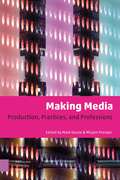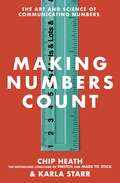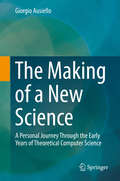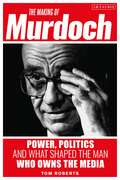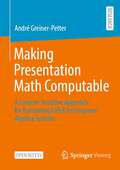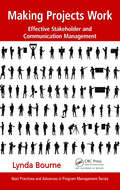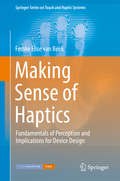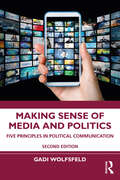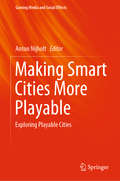- Table View
- List View
Making Media: Production, Practices, and Professions (PDF)
by Edited by Mark Deuz Mirjam PrengerThis book uncovers what it means and what it takes to make media (professionally), focusing on the lived experience of media workers within the global media, including specific case studies of the film, television, games and software, journalism, advertising, and music industries. This carefully edited volume features 35 authoritative essays by 50 researchers from 14 countries across 6 continents, all of whom are at the cutting edge of media production studies. This book is particularly designed for use in coursework on media and cultural production, work, management and industries. It gives readers a critical sense of the key forces, dynamics, and trends shaping the work of those who make media professionally. Specific topics highlighted: - the history of media industries and production studies; - production studies as a field and a research method; - changing media business models, economics, and management; - global concentration and convergence of media industries and professions; - the rise and role of startups and entrepreneurship; - freelancing in the digital age; - the role of creativity and innovation; - the emotional quality of media work; - diversity and inequality in the media industries.
Making Media Theory: Thinking Critically with Technology
by Marcel O’GormanMaking Media Theory is about the study, practice, and hands-on design of media theory. It looks at experimental research methods and engages in media analysis, inviting readers to respond to and shape the materiality of media while carefully considering the implications of living in a technoculture. The author walks readers through the creation of digital objects to think with, where critical design practices serve as tools for exploring social and philosophical issues related to technological being and becoming.
Making Media Theory: Thinking Critically with Technology
by Marcel O’GormanMaking Media Theory is about the study, practice, and hands-on design of media theory. It looks at experimental research methods and engages in media analysis, inviting readers to respond to and shape the materiality of media while carefully considering the implications of living in a technoculture. The author walks readers through the creation of digital objects to think with, where critical design practices serve as tools for exploring social and philosophical issues related to technological being and becoming.
Making Music with Computers: Creative Programming in Python (Chapman And Hall/crc Textbooks In Computing Ser.)
by Bill ManarisTeach Your Students How to Use Computing to Explore Powerful and Creative IdeasIn the twenty-first century, computers have become indispensable in music making, distribution, performance, and consumption. Making Music with Computers: Creative Programming in Python introduces important concepts and skills necessary to generate music with computers.
Making Music with Computers: Creative Programming in Python (Chapman And Hall/crc Textbooks In Computing Ser. #13)
by Bill Manaris Andrew R. BrownTeach Your Students How to Use Computing to Explore Powerful and Creative IdeasIn the twenty-first century, computers have become indispensable in music making, distribution, performance, and consumption. Making Music with Computers: Creative Programming in Python introduces important concepts and skills necessary to generate music with computers.
Making Numbers Count: The art and science of communicating numbers
by Chip Heath Karla StarrHow many hours' worth of songs are on your Spotify Wrapped this year? How much is your commute time really worth? How do you work out how likely you are to get Covid based on the official statistics?How do your viewing hours track against the most popular shows on Netflix?Whether you're interested in global problems like climate change, and understanding that the Australian wildfires destroyed an area twice the size of Portugal, or just grasping how few people have washed their hands between visiting the bathroom and touching your hands, this book will help math-lovers and math-haters alike translate the numbers that animate our world. Until recently, most languages had no words for numbers greater than five. While the numbers in our world have become increasingly complex, our brains are stuck in the past. Yet the ability to communicate and understand numbers has never mattered more. So how can we effectively translate numbers and stats so that the data comes alive? Drawing on years of research into making ideas stick, Chip Heath and Karla Starr outline six critical principles that will give anyone the tools to communicate numbers with more transparency and meaning. Using concepts such as simplicity, concreteness and familiarity, the authors reveal what's compelling about a number and show how to transform it into its most engaging form.
The Making of a New Science: A Personal Journey Through the Early Years of Theoretical Computer Science
by Giorgio AusielloThis book explains the development of theoretical computer science in its early stages, specifically from 1965 to 1990. The author is among the pioneers of theoretical computer science, and he guides the reader through the early stages of development of this new discipline. He explains the origins of the field, arising from disciplines such as logic, mathematics, and electronics, and he describes the evolution of the key principles of computing in strands such as computability, algorithms, and programming.But mainly it's a story about people – pioneers with diverse backgrounds and characters came together to overcome philosophical and institutional challenges and build a community. They collaborated on research efforts, they established schools and conferences, they developed the first related university courses, they taught generations of future researchers and practitioners, and they set up the key publications to communicate and archive their knowledge. The book is a fascinating insight into the field as it existed and evolved, it will be valuable reading for anyone interested in the history of computing.
The Making of Information Systems: Software Engineering and Management in a Globalized World
by Karl E. KurbelInformation systems (IS) are the backbone of any organization today, supporting all major business processes. This book deals with the question: how do these systems come into existence? It gives a comprehensive coverage of managerial, methodological and technological aspects including: Management decisions before and during IS development, acquisition and implementation Project management Requirements engineering and design using UML Implementation, testing and customization Software architecture and platforms Tool support (CASE tools, IDEs, collaboration tools) The book takes into account that for most organizations today, inhouse development is only one of several options to obtain an IS. A good deal of IS development has moved to software vendors – be it domestic, offshore or multinational software firms. Since an increasing share of this work is done in Asia, Eastern Europe, Latin America and Africa, the making of information systems is discussed within a global context.
The Making of Murdoch: Power, Politics and What Shaped the Man Who Owns the Media
by Tom RobertsRupert Murdoch's extraordinary career has no parallel. His control of Fox news, which so successfully supports the Trump presidency, is a key force in American politics. In the UK, his control of The Sun and The Times leaves politicians scrambling to get him onside. But what do we know about the man himself? This book looks closely at the Murdochs, focusing on Rupert's father Keith, who built the family's media power and cultivated the anti-establishment instincts that his son Rupert is known for. Roberts traces the life of the Murdochs, how Rupert Murdoch's view of the world was formed, and assesses it's impact on the media that influences our politics today.
The Making of Murdoch: Power, Politics and What Shaped the Man Who Owns the Media
by Tom RobertsRupert Murdoch's extraordinary career has no parallel. His control of Fox news, which so successfully supports the Trump presidency, is a key force in American politics. In the UK, his control of The Sun and The Times leaves politicians scrambling to get him onside. But what do we know about the man himself? This book looks closely at the Murdochs, focusing on Rupert's father Keith, who built the family's media power and cultivated the anti-establishment instincts that his son Rupert is known for. Roberts traces the life of the Murdochs, how Rupert Murdoch's view of the world was formed, and assesses it's impact on the media that influences our politics today.
Making Presentation Math Computable: A Context-Sensitive Approach for Translating LaTeX to Computer Algebra Systems
by André Greiner-PetterThis Open-Access-book addresses the issue of translating mathematical expressions from LaTeX to the syntax of Computer Algebra Systems (CAS). Over the past decades, especially in the domain of Sciences, Technology, Engineering, and Mathematics (STEM), LaTeX has become the de-facto standard to typeset mathematical formulae in publications. Since scientists are generally required to publish their work, LaTeX has become an integral part of today's publishing workflow. On the other hand, modern research increasingly relies on CAS to simplify, manipulate, compute, and visualize mathematics. However, existing LaTeX import functions in CAS are limited to simple arithmetic expressions and are, therefore, insufficient for most use cases. Consequently, the workflow of experimenting and publishing in the Sciences often includes time-consuming and error-prone manual conversions between presentational LaTeX and computational CAS formats. To address the lack of a reliable and comprehensive translation tool between LaTeX and CAS, this thesis makes the following three contributions. First, it provides an approach to semantically enhance LaTeX expressions with sufficient semantic information for translations into CAS syntaxes. Second, it demonstrates the first context-aware LaTeX to CAS translation framework LaCASt. Third, the thesis provides a novel approach to evaluate the performance for LaTeX to CAS translations on large-scaled datasets with an automatic verification of equations in digital mathematical libraries.This is an open access book.
Making Projects Work: Effective Stakeholder and Communication Management (Best Practices in Portfolio, Program, and Project Management)
by Lynda BourneThis book provides a framework for understanding and managing factors required for achieving successful project and program outcomes. It presents guidelines to help readers develop an understanding of governance and its connection to strategy as the starting point for decisions on what work needs to be done. The book describes how to craft appropriate communication strategies to develop and maintain successful relationships with stakeholders. It highlights the strengths and weaknesses of existing project controls and outlines effective communication techniques for managing expectations and acquiring the support required for successful delivery.
Making Projects Work: Effective Stakeholder and Communication Management (Best Practices in Portfolio, Program, and Project Management)
by Lynda BourneThis book provides a framework for understanding and managing factors required for achieving successful project and program outcomes. It presents guidelines to help readers develop an understanding of governance and its connection to strategy as the starting point for decisions on what work needs to be done. The book describes how to craft appropriate communication strategies to develop and maintain successful relationships with stakeholders. It highlights the strengths and weaknesses of existing project controls and outlines effective communication techniques for managing expectations and acquiring the support required for successful delivery.
Making Robots Smarter: Combining Sensing and Action Through Robot Learning
by Katharina Morik Michael Kaiser Volker KlingsporMaking Robots Smarter is a book about learning robots. It treats this topic based on the idea that the integration of sensing and action is the central issue. In the first part of the book, aspects of learning in execution and control are discussed. Methods for the automatic synthesis of controllers, for active sensing, for learning to enhance assembly, and for learning sensor-based navigation are presented. Since robots are not isolated but should serve us, the second part of the book discusses learning for human-robot interaction. Methods of learning understandable concepts for assembly, monitoring, and navigation are described as well as optimizing the implementation of such understandable concepts for a robot's real-time performance. In terms of the study of embodied intelligence, Making Robots Smarter asks how skills are acquired and where capabilities of execution and control come from. Can they be learned from examples or experience? What is the role of communication in the learning procedure? Whether we name it one way or the other, the methodological challenge is that of integrating learning capabilities into robots.
Making Sense of Cyber Capabilities for Small States: Case Studies from the Asia-Pacific (Routledge Advances in International Relations and Global Politics)
by Francis C. DomingoDomingo explores the potential of cyber capabilities for small states in the Asia-Pacific, the most active region for cyber conflict. He develops a systematic explanation for why Brunei, New Zealand, and Singapore have developed or are developing cyber capabilities. Studies on cyber conflict and strategy have substantially increased in the past decade but most have focused on the cyber operations of powerful states. This book moves away from the prominence of powerful states and explores the potential of cyber capabilities for small states in the Asia-Pacific, the most active region for cyber conflict. It develops a systematic explanation of why Brunei, New Zealand, and Singapore have developed or are developing cyber capabilities despite its obscure strategic value. The book argues that the distribution of power in the region and a "technology-oriented" strategic culture are two necessary conditions that influence the development of cyber capabilities in small states. Following this argument, the book draws on neoclassical realism as a theoretical framework to account for the interaction between these two conditions. The book also pursues three secondary objectives. First, it aims to determine the constraints and incentives that affect the utilization of cyber capabilities as foreign policy instruments. Second, the book evaluates the functionality of these cyber capabilities for small states. Lastly, it assesses the implications of employing cyber capabilities as foreign policy tools of small states. This book will be an invaluable resource for academics and security analysts working on cyber conflict, military strategy, small states, and International Relations in general.
Making Sense of Cyber Capabilities for Small States: Case Studies from the Asia-Pacific (Routledge Advances in International Relations and Global Politics)
by Francis C. DomingoDomingo explores the potential of cyber capabilities for small states in the Asia-Pacific, the most active region for cyber conflict. He develops a systematic explanation for why Brunei, New Zealand, and Singapore have developed or are developing cyber capabilities. Studies on cyber conflict and strategy have substantially increased in the past decade but most have focused on the cyber operations of powerful states. This book moves away from the prominence of powerful states and explores the potential of cyber capabilities for small states in the Asia-Pacific, the most active region for cyber conflict. It develops a systematic explanation of why Brunei, New Zealand, and Singapore have developed or are developing cyber capabilities despite its obscure strategic value. The book argues that the distribution of power in the region and a "technology-oriented" strategic culture are two necessary conditions that influence the development of cyber capabilities in small states. Following this argument, the book draws on neoclassical realism as a theoretical framework to account for the interaction between these two conditions. The book also pursues three secondary objectives. First, it aims to determine the constraints and incentives that affect the utilization of cyber capabilities as foreign policy instruments. Second, the book evaluates the functionality of these cyber capabilities for small states. Lastly, it assesses the implications of employing cyber capabilities as foreign policy tools of small states. This book will be an invaluable resource for academics and security analysts working on cyber conflict, military strategy, small states, and International Relations in general.
Making Sense of Haptics: Fundamentals of Perception and Implications for Device Design (Springer Series on Touch and Haptic Systems)
by Femke Elise van BeekTele operation systems, in which robots are controlled remotely, are a potential solution to performing tasks in remote, small, and hazardous environments. However, there is a big disadvantage to these systems; as the direct connection between the human and the environment is lost and operators are deprived of their sense of touch. The recreation of touch feedback through haptic devices is a possible solution, however haptic devices are far from perfect and improving their design is usually a slow trial-and-error process. This book describes 7 scientific studies that try to break this slow loop by using a deductive approach. Through investigating fundamental properties of human haptic perception using psychophysical paradigms, general knowledge on haptic perception of force, position, movement and hardness was gained. The resulting information can be applied to many different haptic devices. Consequently haptic systems can be more easily designed in an intuitive, human-centered way.
Making Sense of Media and Politics: Five Principles in Political Communication
by Gadi WolfsfeldIn Making Sense of Media and Politics, Gadi Wolfsfeld introduces readers to the most important concepts for examining the interrelationship of media and politics. Five major principles are used to summarize the major arguments: Political power can usually be translated into power over all forms of media. When the powerful lose control over the political environment, they also lose control over all forms of media. Every political story that appears in every form of media is biased. All forms of media are primarily dedicated to telling good stories, which can have a major impact on political processes. Many of the most important effects of the various forms of media on citizens tend to be unintentional and unnoticed. By identifying these five key principles of political communication, Wolfsfeld examines those who package and send political messages, those who transform political messages into stories, and the effects this can have on citizens, and how the more active members of the public ("users") can initiate their own stories. The result is a brief, engaging guide to help make sense of the wider world of media and politics and an essential companion to more in-depths studies of the field. New to the Second Edition Up-to-date coverage of major political events in the last decade, including the landmark US elections of 2016 and 2020. Devotes more attention to the "hybrid media system" that has developed over the last decade, providing a greater balance between traditional "news" and social media in particular. Includes more cross-national research, especially in non-Western and non-democratic countries. Refines the five principles of political communication to better reflect contemporary media trends. Covers key emerging topics including misinformation and threats to democratic institutions, new forms of political engagement, and the economic base of the various forms of media.
Making Sense of Media and Politics: Five Principles in Political Communication
by Gadi WolfsfeldIn Making Sense of Media and Politics, Gadi Wolfsfeld introduces readers to the most important concepts for examining the interrelationship of media and politics. Five major principles are used to summarize the major arguments: Political power can usually be translated into power over all forms of media. When the powerful lose control over the political environment, they also lose control over all forms of media. Every political story that appears in every form of media is biased. All forms of media are primarily dedicated to telling good stories, which can have a major impact on political processes. Many of the most important effects of the various forms of media on citizens tend to be unintentional and unnoticed. By identifying these five key principles of political communication, Wolfsfeld examines those who package and send political messages, those who transform political messages into stories, and the effects this can have on citizens, and how the more active members of the public ("users") can initiate their own stories. The result is a brief, engaging guide to help make sense of the wider world of media and politics and an essential companion to more in-depths studies of the field. New to the Second Edition Up-to-date coverage of major political events in the last decade, including the landmark US elections of 2016 and 2020. Devotes more attention to the "hybrid media system" that has developed over the last decade, providing a greater balance between traditional "news" and social media in particular. Includes more cross-national research, especially in non-Western and non-democratic countries. Refines the five principles of political communication to better reflect contemporary media trends. Covers key emerging topics including misinformation and threats to democratic institutions, new forms of political engagement, and the economic base of the various forms of media.
Making Sense of Organizational Learning: Putting Theory into Practice
by Cyril KirwanThe ability of a business to engage in real organizational learning and to do so faster and in a more sustainable way than its competitors is being increasingly seen as an essential component of success. In Making Sense of Organizational Learning, Cyril Kirwan examines the wide range of factors necessary to create and sustain organizational learning and knowledge at all levels. At the individual level, the generation of continuous learning opportunities and reflection on experiences are critically important. At the team level, it’s about encouraging collaboration, team learning and the sharing of knowledge. At the organizational level, the emphasis is on building systems to capture and share knowledge and providing strategic leadership for learning. The book shows you how you can best exploit the knowledge that already exists within your organization while at the same time develop the capability of the people that work there. It deals in turn with individual learning; learning with others; learning in organizations; and in particular the role of the HR function and of line managers. Each chapter provides theoretical background and real-world examples. Diagnostic questionnaires, checklists and other tools are also included. Making Sense of Organizational Learning provides an evidence-based argument for the adoption of effective organizational learning policies and practices, and offers a real opportunity to improve performance. Thinking practitioners working in and around learning and development or organization development will find it invaluable, as will those undertaking post-graduate study in HR and related disciplines.
Making Sense of Organizational Learning: Putting Theory into Practice
by Cyril KirwanThe ability of a business to engage in real organizational learning and to do so faster and in a more sustainable way than its competitors is being increasingly seen as an essential component of success. In Making Sense of Organizational Learning, Cyril Kirwan examines the wide range of factors necessary to create and sustain organizational learning and knowledge at all levels. At the individual level, the generation of continuous learning opportunities and reflection on experiences are critically important. At the team level, it’s about encouraging collaboration, team learning and the sharing of knowledge. At the organizational level, the emphasis is on building systems to capture and share knowledge and providing strategic leadership for learning. The book shows you how you can best exploit the knowledge that already exists within your organization while at the same time develop the capability of the people that work there. It deals in turn with individual learning; learning with others; learning in organizations; and in particular the role of the HR function and of line managers. Each chapter provides theoretical background and real-world examples. Diagnostic questionnaires, checklists and other tools are also included. Making Sense of Organizational Learning provides an evidence-based argument for the adoption of effective organizational learning policies and practices, and offers a real opportunity to improve performance. Thinking practitioners working in and around learning and development or organization development will find it invaluable, as will those undertaking post-graduate study in HR and related disciplines.
Making Sense of Sensors: End-to-End Algorithms and Infrastructure Design from Wearable-Devices to Data Centers
by Omesh Tickoo Ravi IyerMake the most of the common architectures used for deriving meaningful data from sensors. This book provides you with the tools to understand how sensor data is converted into actionable knowledge and provides tips for in-depth work in this field.Making Sense of Sensors starts with an overview of the general pipeline to extract meaningful data from sensors. It then dives deeper into some commonly used sensors and algorithms designed for knowledge extraction. Practical examples and pointers to more information are used to outline the key aspects of Multimodal recognition. The book concludes with a discussion on relationship extraction, knowledge representation, and management. In today’s world we are surrounded by sensors collecting various types of data about us and our environments. These sensors are the primary input devices for wearable computers, IoT, and other mobile devices. The information is presented in way that allows readers to associate the examples with their daily lives for better understanding of the concepts.What You'll LearnLook at the general architecture for sensor based data Understand how data from common domains such as inertial, visual and audio is processedMaster multi-modal recognition using multiple heterogeneous sensorsTransition from recognition to knowledge through relationship understanding between entitiesLeverage different methods and tools for knowledge representation and managementWho This Book Is ForNew college graduates and professionals interested in acquiring knowledge and the skills to develop innovative solutions around today's sensor-rich devices.
Making Smart Cities More Playable: Exploring Playable Cities (Gaming Media and Social Effects)
by Anton NijholtThis book explores the ways in which the broad range of technologies that make up the smart city infrastructure can be harnessed to incorporate more playfulness into the day-to-day activities that take place within smart cities, making them not only more efficient but also more enjoyable for the people who live and work within their confines. The book addresses various topics that will be of interest to playable cities stakeholders, including the human–computer interaction and game designer communities, computer scientists researching sensor and actuator technology in public spaces, urban designers, and (hopefully) urban policymakers. This is a follow-up to another book on Playable Cities edited by Anton Nijholt and published in 2017 in the same book series, Gaming Media and Social Effects.
Making Social Technologies Work: Leveraging the Power and Managing Perils of Social Technologies in Business (Palgrave Pocket Consultants)
by Ronan GruenbaumEmbracing social technologies at work is not just a blog from the CEO. It is about understanding all the opportunities where social media and technology activities could improve your company from marketing to operations. A practical guide for managers and an informative window into the world of social technologies in business.
Making Supply Chain Management Work: Design, Implementation, Partnerships, Technology, and Profits
by James B. AyersAny supply chain improvement project, even if well conceived, has a good chance of failing, unless the accompanying information technology enables the design. Being prepared, understanding the risks and how to reduce them, will give you the edge you need. Combining a technology focus with practical advice, Making Supply Chain Management Work: Desig
